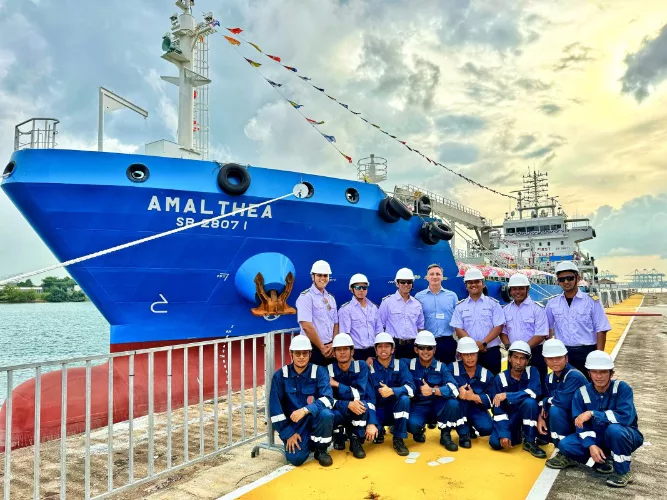Planet
Task Force on Climate-Related Financial Disclosures (TCFD)
The Task Force on Climate-related Financial Disclosures (TCFD) was created by the Financial Stability Board to develop consistent climate-related financial risk disclosures.
Our CSR report has been prepared, to the extent possible, with reference to the recommendations of the TCFD, particularly in the areas of governance, strategy, risk management, and metrics and targets. Our TCFD framework supports the continuous development of our governance, strategy, and risk management during the energy transition. It also sets the metrics and targets for the years ahead.

TCFD framework
Governance
Mercuria’s team includes specialists with expertise in sustainability, supply chains, social responsibility, governance, and health and safety. The team meets regularly—often weekly—with active participation from the Global Head of Corporate Responsibility & Compliance. The Global Head of Corporate Responsibility & Compliance engages in daily discussions about these topics with senior leadership, including Mercuria’s CEO, and presents them at quarterly board meetings. These ongoing engagements ensure that these topics are incorporated into the company’s strategy, including initiatives under Mercuria’s Agenda 2030 and carbon emissions reduction plans.
Strategy
Mercuria has set out a net zero goal by 2050, similar to the Swiss Federal Council climate goals, and continues to work towards this goal. We align our strategy to the Swiss Energy Perspective (EP2050+). According to the Swiss EP2050+, the main levers for reducing emissions in industry are increased energy efficiency, the substitution of fossil fuels with renewable energies and greater electrification.
Since Mercuria’s establishment, we have strategically diversified our trading portfolio, transitioning from a primarily oil-focused business model to one that emphasizes lower-carbon energy sources, with a particular focus on gas and power trading.
This aligns with the objectives of the Swiss EP2050+, which highlights the importance of electrifying the energy system. Electrification serves as both a substitute for higher-carbon fuels and as a supportive backup for renewable energy sources, playing a critical role in the energy transition. Moreover, in 2021, Mercuria formulated a transition plan and pledged that, by 2025, more than fifty percent of our investments would be directed towards the energy transition. Mercuria has achieved and exceeded this commitment ahead of schedule.
In our Climate Disclosure, we align our reporting with the Task Force on Climate-related Financial Disclosures (TCFD) recommendations, which, along with our emissions calculations and materiality analysis, provide a double-materiality assessment of our business. This approach enables us to identify and actively manage climate-related risks and opportunities across short-term, medium-term and long-term horizons.
Climate-related risks
Transition risks
Physical risks
Climate-related opportunities
Resource efficiency
Energy source
Products & services
Markets
Resilience
*Horizons are short 1 year (S), medium 2-5 years (M), and long above 5 years (L)
Risk management
Mercuria’s strategic approach is aligned with its risk management framework. Risk management is a core function of the company, encompassing a wide range of areas including investments, trading activities, market dynamics, and the energy transition. This approach addresses both transitional and physical climate-related risks, which are continuously monitored and proactively mitigated.
We have shifted away from only trading oil toward a diversified portfolio with lower carbon energy sources. This diverse product mix provides a hedge against the impact of policy and regulatory changes on specific products in particular locations. Additionally, it opens access to new markets and potential revenue streams. This year, we have expanded our metals business and started trading critical minerals as part of our commitment to the energy transition.
We also capitalize on diverse investment opportunities, ranging from different types of assets, industries, and geographic locations. As covered by the investments section, our portfolio includes investments in sectors critical to powering the energy transition designed to mitigate the array of risks previously outlined. Furthermore, to enhance our understanding of new markets and incorporate varied perspectives into our investment decisions, we have strategically expanded our investment team to include professionals from a broad spectrum of relevant backgrounds. We have strengthened expertise within our analytics, trading and operational teams, enhancing our operations and driving greater profitability.
In relation to the management of physical risks, we undertake continuous due diligence of our asset holdings as highlighted in our Health, Safety, Security and Environmental (HSSE) section.
Please refer to Risk & Opportunity Oversight for more on our risk management.
Metrics and targets
At Mercuria, we set climate-related targets and measure the progress towards those targets using defined metrics. In the following table, we show the targets and metrics related to our emissions, investments, and percentage traded products.
*All information regarding CO2e emissions, basis of reporting, and standards used are found in the Planet 2024 section
Reporting areas
Governance
Planet
People
Prosperity




